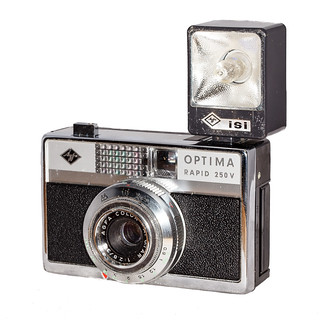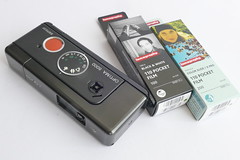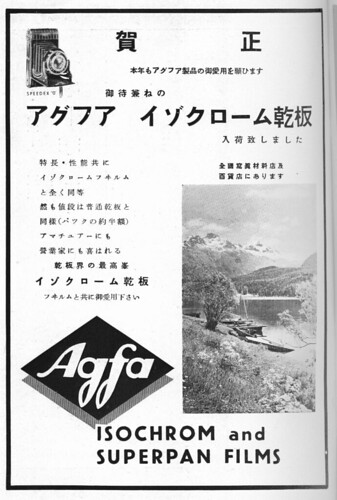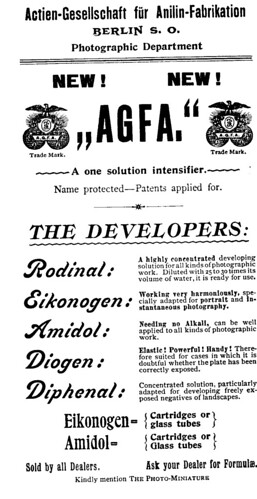Agfa
Contents |
AGFA (abbreviation for Aktien-Gesellschaft für Anilin-Fabrikation) was a major producer of cameras, accessories, film and photographic chemicals, founded in Berlin, Germany in 1867. Since 2007 the brand name is licensed to OEM companies.
 Image by Uwe Kulick (Image rights) | ||||
 |
 |
 |
 |
 |
Image by eBayer Yalluflex (Image rights) |
Image by John Kratz (Image rights) |
Image by Bill Strong (Image rights) |
Image by Goodimages (Image rights) |
Image by Uwe Kulick (Image rights) |
 |
 |
 |
 |
 |
| Agfa films and accessories: | ||||
Image by Dirk HR Spennemann (Image rights) |
Image by Jim Grey (Image rights) |
Image by Nicholas Middleton (Image rights) |
Image by Siim Vahur (Image rights) |
Image by .Castor (Image rights) |
History
In 1867, Chemists Paul Mendelssohn Bartholdy and Carl Alexander von Martius founded Gesellschaft für Anilinfabrikation mbH in Rummelsburg near Berlin. The company produced aniline colors. In 1887 chemical scientist Momme Andresen drove the company to enter photo chemistry. Its first success was in 1888 the developer Rodinal. Later it had problems entering film production since Kodak was years ahead. In 1908 it launched a less flammable security cine film, and in 1910 it opened its big film factory Agfa Wolfen in Wolfen (then in Middle Germany), then the second largest film factory in the world - Kodak in Rochester remained the biggest. During WWI production shifted from photo film to medical x-ray film, aerial photography film, and cine film for the soldiers' field cinemas. Filters and glasses for gas-masks were also made.
In 1925, Agfa was one of the companies that merged to form Interessen-Gemeinschaft Farbenindustrie (IG Farben), a huge corporation covering many dye, photographic and associated industries. As part of the merger, Agfa obtained the Rietzschel camera works in Munich from Bayer, and badged all Rietzschel products with its Agfa rhombus. Several of Rietzschel's cameras were continued, including the Isolar and Ninon, but in 1926 the first real Agfa camera was introduced, the Standard, in both plate/film pack and roll film models. In 1927 the name Rietzschel disappeared from the products, though the heritage of Rietzschel can be traced in Agfa camera and lens names for many years after. In that year the successful Billy camera series was introduced. In 1928 the US division of Agfa entered a merger with Ansco, and over the following 15 years many models from the two companies were sold under the joint name Agfa Ansco.
In 1930 the first Agfa Box camera for 6×9 cm exposures on roll film was produced. In the following year it popularized photography in Germany by dumping the Box 44 for 4 Reichsmark, easily recouping its losses afterwards by selling Agfa 120 roll films. In 1937 it brought out its first camera for 35mm film. After the USA entered the War in 1941, Agfa lost Ansco which began its own film production afterwards. Agfa introduced its modern color negative still photography film and paper in 1942 as base of the Agfacolor films and papers that became competitors for Kodacolor after the war. After the war cooperation with Ansco was revived, but only on the camera sector.
Shortly after the Second World War, IG Farben was broken up by the occupying powers because of its close association with the Nazi government. Some of the assets located in the Soviet-occupied part of Germany were taken in reparations, but some continued to operate (for example, the plant in Wolfen continued, first using the Agfa brand, then renamed as ORWO). Agfa incorporated UCA in Bremen which became a camera factory, and later also Iloca and Staeble to enhance production capacity. For own shutter production it took over two clock makers. In 1964 it even took over its main German competitor, Perutz.
Agfa improved its prewar camera models and introduced the new 35mm Solinette. In 1954 it modernized its camera design with the Silette series. The pre-War Isolette was the basis of the highly successful series of medium format folders in the 50s, culminating in the Super Isolette and the Automatic 66 (a folding camera with aperture priority AE, in 1956!). In 1959 a 35mm viewfinder camera with auto-exposure button followed, the Optima. In 1964, Agfa-Gevaert was formed with the merger of Belgium film and paper manufacturer Gevaert. The Rapid system was introduced as an answer to Kodak's 126 film. The company debuted cameras accepting 126 film in 1967.
In 1968 Agfa introduced its red sensor point, a round membrane made of red foil and framed with a metal ring. Depending on the camera type, either a mechanical or an electromechanical shutter release button was hidden under the flexible membrane. Since then this touchpad-like shutter button was used on most of the company's models and became a familiar feature.
In Germany Agfa had a huge success with its popular "Ritsch-Ratsch" pocket cameras, which accepted 110 cartridge film. A whole series of these Agfamatic cameras was launched twice, the first series using magicubes and the second, flipflash. Of course these cameras had the red sensor point as shutter release button.
In the early 1980s Agfa produced its last film cameras. The new models of the Selectronic series were manufactured by Chinon. Agfa gave up camera production in 1983 after having been taken over by Bayer in 1981. All later Agfa film cameras were OEM products.
In the mid to late 1990's Agfa sold low end compact digital photography cameras under the Agfa ePhoto name, while their desktop scanners were called Agfascan. In 1997, it had acquired Dupont's printing and graphic arts film business.[1] In 2001, they stopped production and ended support for both their consumer scanners and digital cameras.
In 2004, consumer film production ended.[2] A management buy out of the consumer imaging division was made to form the company named AgfaPhoto, soon after AgfaPhoto files for bankruptcy[3]. Some of the factories and machinery from Leverkusen were sold. AgfaPhoto is now a holding company and licences branding to other manufactures.
The AgfaPhoto brand is licensed by German photographic company Plawa which sells a modest line of AgfaPhoto Sensor compact digital cameras. Lupus Imaging[4] is another licence holder of the name AgfaPhoto: they produced the Vista line of 35mm color film that was Made in EU, by Ferrania. In about 2010, they also distributed APX black and white films in 100 and 400 ISO in 35mm format that was from older master rolls. These were also used by Maco as Rollei Retro 100. By August 2013 the older rolls were used up and they began marketing a new version of the film now with a "New Emulsion" badging and marked Made in EU. As of 2023, Lupus distributes both disposable and 'reusable' 35mm cameras; the reusables are very likely versions of the Vibe 501F camera made in China, styled with a different body shell.
Currently (2012), Agfa-Gevaert (Belgium) is still producing industrial film for the medical, semiconductor and graphic press industry. A couple of companies like Maco using the Rollei brand and Fotoimpex using the Adox brand continued production on some of the film and paper products. In Japan, Powershovel has licensed the AgfaPhoto brand for Vista print and CT Precisa slide film. The films are sold and manufactured in Japan[5].
Plate cameras
- Isolar and Isolar Luxus (6.5×9 and 9×12 cm)
- Ninon (6.5x9 horizontal)
- Opal Luxus
- Agfa RPS 2024
- Standard (6.5×9 and 9×12 cm; also in sizes for roll-film - see below)
- Agfa Ansco View Cameras (field cameras in quarter-plate, 4x5, 5x7 and 8x10-inch sizes; strictly Ansco cameras)
Large roll-film cameras
- Superior (8x14 cm/3¼x5½ inch on 122 film; Agfa G6 size)
- Standard (6.5x11 cm on 116 film; also in sizes for plates and 120 film)
120 film cameras
Folding
- Automatic 66
- Billette
- Agfa Billy
- Agfa Billy-Clack
- Agfa Billy Compur
- Agfa Billy I
- Billy II
- Agfa Billy Jgetar 8.8
- Agfa Billy Record
- Agfa Billy Record II
- Isolette (or Jsorette, Jsolette)
- Isolette V
- Isolette I
- Isolette II
- Isolette III
- Isolette L
- Super Isolette
- Nitor
- Agfa Record I
- Agfa Record II
- Agfa Record III
- Standard (also made for 116 film, and for plates)
- Ventura 66
- Ventura 69 (Billy Record)
Rigid
Box
- Box B-2
- Trolix (also known as Box 14)
- Box 34
- Box 44
- Box 50 / Synchro Box
- Agfa Box I (model 54)
- Agfa Box-Spezial (model 64)
620 & 616 film cameras
(Agfa/Ansco designations PB20 & PD16)
127 film cameras
- Agfa Billy 0 (Zero)
35mm film cameras
Folding
Fixed lens (viewfinder)
- Isoly 100
- Optima
- Optima Sensor 200 - 1969 series
- Optima Sensor 500 - 1969 series
- Optima Sensor Electronic - 1978 series
- Compact Electronic (Optima 935) – 1980
- Selecta
- Selecta m
- Selectronic Sensor
- Silette
- Agfa Registrierkamera
Fixed lens, half-frame

|
| Agfa Parat Family image by Jörg Krüger (Image rights) |
- Parat camera family
Rangefinder, fixed lens
Rangefinder, interchangeable lens
SLR
- Agfaflex I/II aka Colorflex I/II
- Agfaflex IV
- Ambiflex aka Agfaflex III/IV/V
- Selectaflex
- Selectronic - series
- Selectronic 3
TLR
Rapid film cameras

|
| Agfa Optima Rapid 250 V image by Jaap Schelvis (Image rights) |
- Iso-Rapid I
- Iso-Rapid IF
- Iso-Rapid Ic
- Iso-Rapid C
- Isoflash Rapid
- Isoflash-Rapid C
- Isomat Rapid
- Isomat Rapid C
- Moto-Rapid C
- Optima Rapid 250
- Silette Rapid I
- Silette Rapid F
- Silette Rapid L
- Optima Rapid 100C
- Optima Rapid 125C
- Optima Rapid 150
- Optima Rapid 250V
- Optima Rapid 500V
126 film cameras
- Iso-Pak
- Iso-Pak C
- Iso-Pak Ci
- Autostar
- Autostar X-126
- Agfamatic
- Agfamatic X-126
- Agfamatic 126
- Agfamatic 50
- Agfamatic 50S
- Agfamatic 55C
- Agfamatic 100
- Agfamatic 108
- Agfamatic 200
- Agfamatic 208
- Agfamatic 300
110 film cameras
The series 1000/2000/... accepted magicubes.
The series 508/1008/... accepted flipflash.
The sophisticated models had a special hot shoe for the Agfamatic Lux flashes.

|
| Agfa OPTIMA 5000 pocket sensor image by Rainer Marx (Image rights) |
- Agfa Mini
- Agfamatic 508 pocket sensor
- Agfamatic 1000 pocket sensor
- Agfamatic 1000S pocket sensor
- Agfamatic 2000 pocket sensor
- Agfamatic 3000 pocket sensor
- Agfamatic 3000 Flash Pocket
- Agfamatic 4000 pocket sensor
- Agfamatic 1008 tele pocket sensor
- Agfamatic 2008 pocket sensor
- Agfamatic 2008 tele pocket sensor
- Agfamatic 3008 pocket sensor
- Agfamatic 4008 pocket sensor
- Agfamatic 5008 makro pocket sensor
- Agfamatic 6008 makro pocket sensor
- Optima 5000 pocket sensor
- Optima 6000 pocket sensor
- Agfa Easy
- Autostar pocket
- Agfamatic 901 motor
- Agfamatic 901E motor
- Agfamatic 901S motor
- Agfa Tramp
- Agfa Traveller
- Snapper
APS film cameras
- Agfa Futura
- Agfa Futura Af zoom
- Agfa Futura FF
Digital
- ActionCam (1995)
- StudioCam (1995)
- ePhoto 1280 (1997 0.7 megapixel)
- ePhoto 1680 (1998 1.2 mp)
- ePhoto 307 (1997)
- ePhoto 780
- ePhoto 780c
- ePhoto CL18 (2000, 0.3 mp)
- ePhoto CL20
- ePhoto CL30 (1999, 0.9 mp)
- ePhoto CL30 Clik! (1999, 0.9 mp)
- ePhoto CL34 (2001, 1.3 MP, Zoran Coach processor)
- ePhoto CL45 (2001; 0.7 mp)
- ePhoto CL50 (1999 1.2 mp)
- ePhoto Smile (0.3 mp)
Film
See → Agfa film
Chemicals
Accessories
- Agfatronic electronic flash units
- Agfa flashbulb units
- Agfa flash lamp
- Light meters
 
|
| Advertisements for Agfa products in Asahi Camera February 1930 and Shashin Salon January 1934. (Image rights) |
Bibliography
- Asahi Camera. Advertisement in February 1930 (p.A20).
- Shashin Salon. Advertisement in January 1934.
Notes
- ↑ Agfa-Gevaert in Film Deal with Dupont - New York Times, Aug 7, 1997.
- ↑ Agfa pulls out of photo film, shares surge - USA Today, Aug 17, 2004.
- ↑ AgfaPhoto files for bankruptcy protection - Sydney Morning Herald, May 30, 2005
- ↑ Lupus Imaging website
- ↑ Agfaphoto with PowerShovel
Links
| Camera industry in Berlin |
| Agfa | Amigo | Astro Berlin | Bermpohl | Bopp | B+W | Foth | Goerz | Grass & Worff | Levy-Roth | Ernst Lorenz | Plasmat | Rudolph | Rothgiesser & Schlossmann | Rüdersdorf | Schulze & Billerbeck | Sida | Stegemann | Romain Talbot |
| Camera industry in Munich |
| Agfa | Deckel | Eder | Enna | Friedrich | Kilfitt | Leitmeyr | Linhof | Niezoldi & Krämer | Perka | Rex | Rietzschel | Rodenstock | Staeble | Steinheil |
- Orphancameras.com, The Butkus camera manual over 100 Agfa camera manuals in PDF format. The site also includes old camera mail-order catalogues from the 40s and 50s listing prices and abilities.
- Agfa page at Collection G. Even's site (in French)
- Cameras and User Manual at www.collection-appareils.fr (in French)
- Flickr group agfa photography
- Agfa cameras in Andrys Stienstra's camera collection



